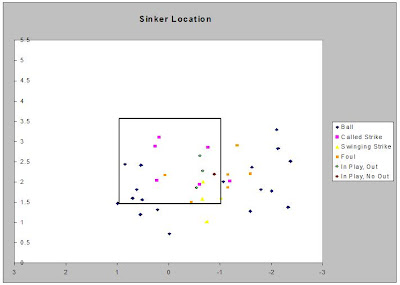After a nice extra inning win on the road yesterday, the Red Sox look to keep the winning ways going tonight in Baltimore. The Sox will be starting Jon Lester while the O's will be throwing Garrett Olson. We have looked at Jon Lester a lot already on this blog so let us take a look at Garrett Olson.
Olson is a lefty who was drafted #48 overall in the 2005 draft. He started 2008 in AAA but has been effective in his 33 innings of work this year for Baltimore. He is 4-1 with a 4.09 era and 26-13 K's to BB. In fact, he has actually pitched much better than his ERA indicates. The ERA is inflated due to a rocky start vs NYY on 5/21 in which he gave up 6 runs in 2.2 innings.


Versus left handed hitters, he is mainly a fastball/changeup guy. Very little sliders to the lefty and will only use it when he gets ahead in the count. Versus right handed hitters he will throw that slider all day until he gets to three balls.
Here is his slider locations versus right handed hitters:

This chart is from the catchers view. He is trying to pound the zone down and in, but tends to leave some of the sliders over the heart of the plate. If he can keep that slider down tonight, expect him to be effective against a RH heavy lineup.
Before we finish up, here is Olson's release point for his fastball and changeup. I figured since he only throws lefties these two pitches, would a hitter be able to recognized the pitch from his release point? This data shows the difference, but I'm not sure how much of a difference it is for a hitter to be able to pick up on it.
From the catcher's view:

Quick note, the points that are in the oval are from his 5/21 start versus the Yankees where he got rocked. Three things could have happened: he was either working from a different part of the mound, his mechanics were off or the system was off. Either way, something was happening.
So back to the rest of his starts. You can see that his changeup comes more from the right of the graph. Would this mean he is extending his arm more when he releases that pitch compared to the fastball?
Now it is easy to sit here and see the difference. But we really don't know if it is visible to a hitter.
I am looking forward to watching Olson vs the Sox tonight. Should be a good one.
























